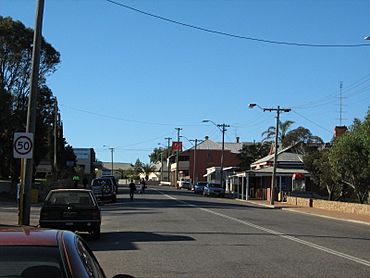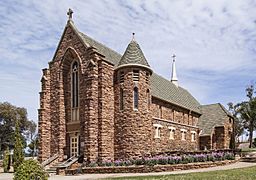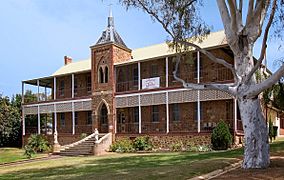Northampton, Western Australia facts for kids
Quick facts for kids NorthamptonWestern Australia |
|||||||||
|---|---|---|---|---|---|---|---|---|---|

Hampton Street
|
|||||||||
| Established | 1864 | ||||||||
| Postcode(s) | 6535 | ||||||||
| Area | [convert: needs a number] | ||||||||
| Location | |||||||||
| LGA(s) | Shire of Northampton | ||||||||
| State electorate(s) | Moore | ||||||||
| Federal Division(s) | Durack | ||||||||
|
|||||||||
Northampton is a town located about 52 kilometers (32 miles) north of Geraldton. It is in the Mid West region of Western Australia. In 2011, about 868 people lived there. The town has a special building protected by the National Trust of Australia. It sits along the North West Coastal Highway.
Northampton was first called The Mines. It was officially named in 1864 after the Governor of Western Australia, John Hampton. The town was built in the Nokanena Brook valley. This area was between two important copper mining spots, Wanerenooka and Gwalla.
It used to be the closest town to a tiny, self-declared country called the Principality of Hutt River.
Northampton is also famous for its many beautiful wildflowers. Old cave paintings found near the Bowes River show that Indigenous Australians have lived in this area for a very long time.
Farmers in the surrounding areas grow wheat and other cereal crops. The town has a special site where farmers can deliver their grain.
Contents
History of Northampton
The mining industry in Western Australia began in 1848. This was when Lead ore was first found by explorer James Perry Walcott. He was part of Augustus Charles Gregory's group. They found the ore in the bed of the Murchison River.
By 1864, the district was exporting a lot of lead and copper ore. These exports made up 14% of the colony's total exports. Only wool and sandalwood were exported more. By 1877, copper and lead exports had grown even more. They were still the colony's second largest export.
In 1900, the town was flooded after very heavy rain. The bridge over Nokanena Brook was covered by water and badly damaged. The water levels were the highest seen in ten years.
In 1936, the Northampton area produced 4,628 tons of lead. This increased to 6,163 tons in 1937. Most of this came from the Grand Junction mine, which closed in 1938.
The Northampton State Battery opened in 1954. It worked for about 30 years. This process left behind large piles of waste material called "tailings." Local people used this waste in buildings and other construction. The battery was taken down in 2010. The remaining waste was safely stored in a special area.
In 2013, an investigation started to check for lead in the town. The Northampton Lead Tailings Project aims to gather information about all the land around the town. This helps them understand where the old mining waste, which contains a small amount of lead, might be.
In April 2021, Tropical Cyclone Seroja caused serious damage to the town. The cyclone hit the coast as a strong storm.
Northampton's Special Buildings
Northampton is one of the oldest towns in Western Australia. It was officially made a town in 1864. In 1993, the National Trust of Australia (WA) called it a "historic town." This was because of its important old buildings that are still used today.
Two famous buildings were designed by a priest and architect named Mgr Hawes. The most important is the Church of Our Lady in Ara Coeli. It was built around 1936. It is a beautiful stone building with a romantic old style. Next to the church is the Convent of the Sacred Heart. Mgr Hawes also built this in 1919. It has a more common Australian style with deep wooden verandahs to block the sun. Both buildings are officially protected as part of Western Australia's heritage.
- Mgr Hawes's Buildings
Transport in Northampton
The first government railway in Western Australia was built from Geraldton to Northampton. It was about 53 kilometers (33 miles) long. This railway opened on July 26, 1879. Later, the line was extended from Northampton to Ajana. This extension opened on March 13, 1913. The railway line closed on April 29, 1957.
Famous People from Northampton
- Sir David Brand (1912–1979) was the 19th Premier of Western Australia. A Premier is like a state leader.
- William Burges (c. 1806–1876) was a farmer and a local leader. He was also a member of the Legislative Council.
- Jamie Cripps is an Australian rules footballer.
- Patrick Cripps is also an Australian rules footballer.
- John Drew (1865–1947) was a newspaper publisher. He held several important government jobs, including Minister for Agriculture and Minister for Education.
- Paul Hasleby is an Australian rules footballer.
- Herbert Johnson (1889–1962) was a federal Minister for the Interior.
- Josh J. Kennedy is an Australian rules footballer.
- Andrew Lockyer is an Australian rules footballer.
- Samuel Mitchell (c. 1838–1912) was a pioneer in the mining industry. He was also a member of the Legislative Council and Legislative Assembly.
- Harry Taylor is an Australian rules footballer.
- Brynn Teakle is an Australian rules footballer.





